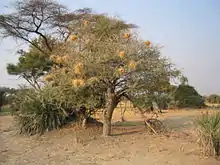White-browed sparrow-weaver
The white-browed sparrow-weaver (Plocepasser mahali) is a predominantly brown, sparrow-sized bird found throughout central and north-central southern Africa.[2] It is found in groups of two to eleven individuals consisting of one breeding pair and other non-reproductive individuals.
| White-browed sparrow-weaver | |
|---|---|
 | |
| Male, Baringo Lake, Kenya
| |
| Scientific classification | |
| Kingdom: | Animalia |
| Phylum: | Chordata |
| Class: | Aves |
| Order: | Passeriformes |
| Family: | Ploceidae |
| Genus: | Plocepasser |
| Species: | P. mahali |
| Binomial name | |
| Plocepasser mahali Smith, 1836 | |
Taxonomy and systematics
During his expedition to the interior of southern Africa in 1834–35, Andrew Smith collected specimens of the white-browed sparrow weaver at the Modder River, which he described in 1836, giving it the scientific name Plocepasser mahali.[3]
Etymology
Smith did not provide an explanation for the species epithet mahali, but is clear it is not a Latin name. Probably it is derived from the vernacular name for the bird in Setswana mogale or from the Sesotho word mohale, a brave or fierce person, which suggests the bird's name may refer to its angry scolding.[3]
Vernacular names
Other common names used in English include black-billed mahali weaverbird, black-billed sparrow weaver, Kismayu sparrow-weaver, stripe-breasted sparrow-weaver, white-browed weaver bird, and white-crowned weaver bird.[4]
Subspecies
There are four recognized subspecies of the white-browed sparrow-weaver:[5]
- P. m. melanorhynchus is found in eastern Africa
- P. m. pectoralis is found from Botswana to Tanzania and western Mozambique
- P. m. ansorgei is found in southern Angola and northern Namibia
- P. m. mahali is found from southern Namibia to Zimbabwe and South Africa
Description
It ranges from 17 to 19 cm (6.7 to 7.5 in) in length and is characterized by a broad, white eyebrow stripe and white rump visible in flight. While the male white-browed sparrow-weaver sports a black bill, the female's bill is horn-colored (light gray); that of the juvenile is pinkish-brown. In Zimbabwe, the white-browed sparrow-weaver shows faint brown spotting across its white breast.[6]
Voice
The white-browed sparrow-weaver may emit either a brief chik-chick or a loud, fluid, cheoop-preeoo-chop whistle.[6]
Similar species
The yellow-throated petronia has a pinkish brown (not black) bill, a buff (not white) eyebrow stripe, black (not pink) feet, and yellow shading at the bottom of a white throat. Additionally, the white-browed sparrow-weaver is larger than the yellow-throated petronia. Unlike the white-browed sparrow-weaver, the yellow-throated petronia may be found in broad-leaved woodland.[6]
Distribution and habitat
The white-browed sparrow-weaver is found in greatest numbers in north-central southern Africa. While this species most densely populates dry regions with woodland or wooded grassland at northern South Africa, its range includes Botswana, northern and central Namibia, and western Zimbabwe. It is seen very often in South Luangwa National Park, Zambia and southern Malawi. Populations may be found as far north as Ethiopia. Populations are sedentary.[2]
This species nests in colonies along thornveld and scrubby, dry riverbanks.[6]
Behaviour and ecology
Breeding
Breeding has been observed year round, but occurs mainly in warmer months.[2] Year round, groups of the white-browed sparrow-weaver are active and nest-building. Groups of ten to sixty inverted-U-shaped nests of dry grass appear in the outside limbs of trees, although only several are used for breeding or roosting. While breeding nests have only one entrance, roosting nests have an entrance located at each of the two nest extremities. Research has shown that, throughout a region, nests are located at the leeward side of a tree. This behavior preserves a greater number of intact nests for breeding and roosting. White-browed sparrow-weaver nests are sometimes used by other birds, such as the red-headed finch and ashy tit.[7]
Status
The white-browed sparrow-weaver is becoming more abundant, expanding its range on southern, northern, and eastern fronts.[2]
 Juvenile in Namibia
Juvenile in Namibia Male in nest in Kenya
Male in nest in Kenya White-browed sparrow-weaver nests in Botswana, Africa
White-browed sparrow-weaver nests in Botswana, Africa An acacia tree with white-browed sparrow-weaver nests in the Okavango Delta, Botswana
An acacia tree with white-browed sparrow-weaver nests in the Okavango Delta, Botswana
References
- BirdLife International (2012). "Plocepasser mahali". IUCN Red List of Threatened Species. 2012. Retrieved 26 November 2013.CS1 maint: ref=harv (link)
- Harrison, J. A.; Allan, D. G.; Parker, V.; Brown, C. J. (1997). The Atlas of South African Birds (PDF). BirdLife South Africa. p. 532.
- "White-browed Sparrow-Weaver Plocepasser mahali". Weaver Watch – Monitoring the Weavers of the World. Retrieved 2017-05-17.
- "Mahaliwever". Avibase. Retrieved 2017-04-17.
- IOC World Bird List
- Sinclair, Ian; Hockey, Phil; Tarboton, Warwick (2002). Princeton Field Guides: Birds of Southern Africa. Princeton, New Jersey: Princeton University Press. pp. 396–397. ISBN 0-691-09682-1.
- Ferguson, J. W. H.; Siegfried, W. R. (January–February 1989). "Environmental Factors Influencing Nest-Site Preference in White-Browed Sparrow-Weavers (Plocepasser Mahali)" (PDF). The Condor. 91 (1): 100–107. doi:10.2307/1368152. JSTOR 1368152. Retrieved 1 March 2007.
External links
| Wikimedia Commons has media related to Plocepasser mahali. |
- White-browed Sparrow-Weaver – Species text in Weaver Watch.
- Species text in The Atlas of Southern African Birds
- BirdLife International species factsheet

_male.jpg.webp)
_female.jpg.webp)
_female.jpg.webp)
_male.jpg.webp)